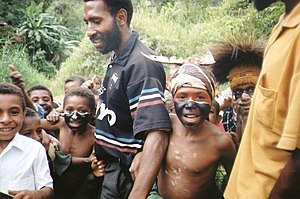Papua New Guinean people

Children dressed up for sing-sing in Yengisa, Papua New Guinea.
|
|
| Regions with significant populations | |
|---|---|
|
(West Papua (region) and Maluku Islands) |
|
| Languages | |
|
Papuan languages Trans–New Guinea languages Indonesian language |
|
| Religion | |
|
Christianity (Protestantism, Roman Catholicism) Sunni Islam Animism |
|
| Related ethnic groups | |
|
Indigenous Australians Melanesians Moluccans |
Papuan people are the various indigenous peoples of New Guinea and neighbouring islands, speakers of the Papuan languages. They are often distinguished ethnically and linguistically from Austronesians, speakers of a language family introduced into New Guinea about three thousand years ago.
In a 2005 study of ASPM gene variants, Mekel-Bobrov et al. found that the Papuan people have among the highest rate of the newly evolved ASPM haplogroup D, at 59.4% occurrence of the approximately 6,000-year-old allele. While it is not yet known exactly what selective advantage is provided by this gene variant, the haplogroup D allele is thought to be positively selected in populations and to confer some substantial advantage that has caused its frequency to rapidly increase.
...
Wikipedia
